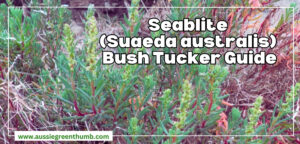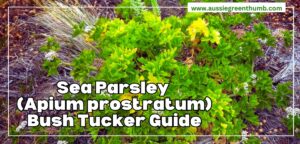Grevillea ‘Ned Kelly’ is a hardy, showy and low-maintenance grevillea cultivar that is loved for its abundant blooms and highly ornamental evergreen foliage.
If you’re considering a new feature plant for your garden, this popular hybrid may be an excellent choice for you. Here is everything you need to know to grow and care for this beloved Australian native shrub.
More...
Genus | Grevillea |
|---|---|
Cultivar: | ‘Mason’s Hybrid’ |
Hybrid of: | Grevillea banksii × Grevillea bipinnatifida |
Family: | Proteaceae |
Common Names: | Ned Kelly, Kentlyn |
Location: | Outdoor |
Type: | Shrub |
Growth: | 1.5 to 2 metres tall, 2 to 3 metres wide |
Sun requirements: | Full sun to partial shade |
Foliage Colour: | Green |
Flower Colour: | Red, orange |
Flowering: | All year |
Maintenance level: | Low |
Poisonous for pets: | Toxic to cats and dogs |
About Grevillea ‘Ned Kelly’
Grevillea ‘Ned Kelly’ features vibrant reddish-pink to orange flowers that bloom throughout most of the year with dense, stiff and heavily divided fern-like foliage.
Adored by nectar loving wildlife, this shrub is also a very water-wise option for the garden. The evergreen, spreading growing habit can complement almost any garden and this plant can offer a few applications within your landscape.
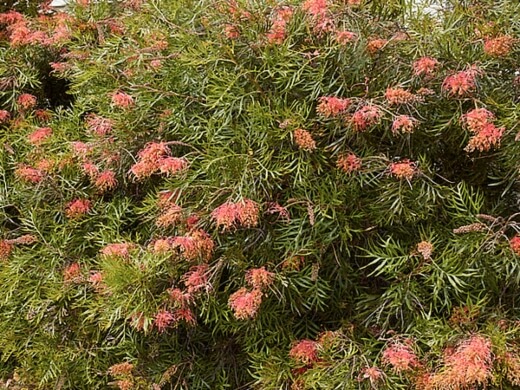
Source: bluedale.com.au
This cultivar, known as Grevillea ‘Mason’s Hybrid’, is a cross between Grevillea banksii and the more upright form Grevillea bipinnatifida registered by Mr J.B. Mason in 1980 in New South Wales.
Commonly known as Ned Kelly or Kentlyn, this medium-sized shrub can grow in a range of climates from warm to cooler, more subtropical climates. Part of the Proteaceae family, this evergreen is fast-growing and very hardy.
Growing to an average size of 1.5 to 2 metres tall and 2 to 3 metres wide, this shrub is widely used as a feature plant, hedge or screen within gardens and the showy blooms make for excellent cut flowers too.
Grevillea ‘Ned Kelly’ can cause skin irritation for people and pets so be sure to plant it away from high traffic areas or spots where the kids and animals frequent.
Grevillea ‘Ned Kelly’ Companion Plants
These ornamental shrubs can suit both relaxed or more formal garden settings and they are perfect for native gardens that attract wildlife like birds, bees, butterflies and other insects.
Here are a few fantastic companion plants to consider for your grevillea:
- Billy buttons
- Grass trees
- Kangaroo paw
- Lilly pilly
- Native daisy
- Banksia ‘Birthday Candles’
- Acacia ‘Greenmist’
How to Grow Grevillea ‘Ned Kelly’

Source: oznativeplants.com
Being a native hybrid plant, this shrub can tolerate growing in a few different conditions and locations, being well suited to our sometimes-harsher environments.
Planting should be done in spring to early summer. For the best growing results, here are the ideal conditions for the Kentlyn grevillea.


Get Your Free Guide:
Master Growing Australian Natives eBook
A Must Have Complete Guide for Every Australian Garden
Get Your Free Guide:
Master Growing Australian Natives eBook
A Must Have Complete Guide for Every Australian Garden
Sunlight
The plant will grow best in sunny positions with as much full sun as possible. It will also be able to grow in more shaded spots but growth and flowering may be slightly stunted until the plant has fully established itself.
Soil for Grevillea ‘Ned Kelly’
Loamy or sandy loam soils that are well-draining will be best for growing your grevilleas but they will also tolerate poorer soils as well.
Temperature & Humidity
General garden humidity should be perfect for this plant. This shrub will grow in most temperatures down to around -5°C. For the best results, warm daily temperatures are recommended.
Grevillea ‘Mason’s Hybrid’ Propagation

Source: glendoragardens.com
This cultivar is known to be a little difficult to successfully propagate. They are not grown from seeds as the hybrid origin of these plants means seeds won’t come true to type.
Healthy, young tubestock plants with new roots can be purchased from reputable garden centres or local nurseries that you can quickly establish in your garden.
Alternatively, these shrubs can be reliably propagated in summer using stem cuttings.
Propagating Grevillea ‘Ned Kelly’ Using Stem Cuttings
- Using a sharp pair of scissors or shears, take half ripened, healthy cuttings from the parent plant's stems.
- Prepare your containers with a quality propagation mix and place your cuttings into the soil.
- Water well after planting to settle the cuttings in the soil mix.
- Place your cuttings in a warm location away from too much direct sunlight.
- Keep the soil moist to the touch for the first few weeks to help encourage healthy root development.
- New roots will begin to grow after about 2 to 3 months depending on the conditions.
- Once your cuttings have good new root development, you can move them to their permanent positions in your landscape.
How to Plant Grevillea ‘Mason’s Hybrid’

Source: andreasensgreen.com.au
Planting in the Garden
- Choose a location in your garden that gets full sun to partial shade daily.
- Dig a planting hole that is at least twice as wide and to the same depth as the root ball of your plant.
- Gently remove your plant from its current container and try not to disturb the roots as much as you can.
- Place your plant in the hole and backfill with soil.
- You can optionally create a raised bed for your plant to ensure good drainage.
- Water well after planting to help settle the soil around the root ball.
- Keep the soil slightly moist for several weeks while the plant establishes itself.
- Add some native fertiliser occasionally to ensure strong root development.
Grevillea ‘Ned Kelly’ Hedge & Screening
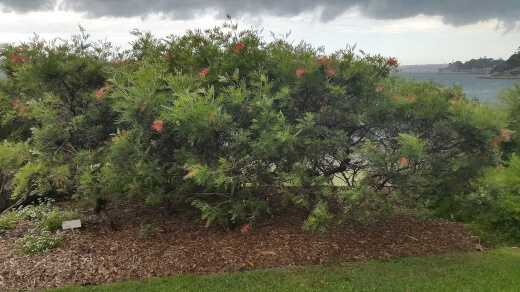
Source: alpinenurseries.com.au
- Plant your grevilleas at least 50cm apart for hedging or screening purposes.
- Certain areas may have laws or local legislations that govern which plants can be used as hedges or how tall they are allowed to be.
- This shrub is known to be an excellent native hedge plant and it will respond well to light and frequent pruning for tidiness and shape.
- When laying your hedge, use well-draining soil and organic compost to encourage dense growth.
Caring for Grevillea ‘Mason’s Hybrid’
Once established, these native shrubs are lightly frost tolerant and are resistant to drought, meaning they are also a great option for more eco-friendly gardens.
Generally, grevilleas are known to be excellent low-maintenance additions to the garden. However, here are a few care tips to ensure you have a healthy and happy plant.
Watering Grevillea ‘Ned Kelly’
For the first 8 to 12 weeks after planting, the shrub will need more frequent waterings to help it settle in your garden. Thereafter once established, it will need little water.
It is recommended to water about once per week. Dry conditions or long periods without rain shouldn’t trouble your shrub.

Source: thetutuguru.com.au
Ideal Pruning Routine
It is recommended to lightly prune your grevillea after flowering to promote dense growth. For hedging, light but more frequent pruning can be done to keep your hedge tidy and in shape. For wilder gardens, pruning can be kept to a minimum for a bushier appearance.
Fertilising Kentlyn Grevillea
Feed with a slow-release native fertiliser when buds begin to form on your plant or in late autumn to encourage growth in the upcoming warmer months. Grevilleas can be sensitive to phosphorus so try to use a fertiliser with the P ratio under 3% for the best results.
Common Grevillea Ned Kelly Pests & Diseases
These hardy shrubs rarely struggle with any pest problems or diseases when grown in the right conditions. They are very much self-sustainable once established but they are sensitive to wet feet.
Prolonged periods in wet conditions can lead to serious problems for you Grevillea ‘Ned Kelly’. That is why it is recommended to plant grevilleas on a sloped or raised garden bed to ensure healthy soil drainage.
Phytophthora cinnamomi
Also known as cinnamon fungus, this disease can kill your grevillea. If your plant has been growing in soggy soil for extended periods, it will be especially susceptible to this deadly disease.
The leaves of infected plants will start to wilt and turn yellow or reddish-purple. To prevent this problem, be sure to stick to a good watering routine, being careful not to overwater your plants.
Treating this disease with the fungicide Phosphonate (Phosphite) can help in boosting the plant’s natural defences but it can also lead to other issues like dieback.
It is recommended to remove and destroy infected plants from your landscape as soon as possible.
Grevillea ‘Ned Kelly’ Frequently Asked Questions

Source: oznativeplants.com
Is a grevillea a tree or shrub?
The grevilleas are members of the Protea family and are some of the most commonly used shrubs in Australia. They produce vivid flowers and come in many forms and sizes.
Do grevilleas have invasive roots?
No, these plants feature shallow root systems so they aren’t a threat to pipes, paving or buildings.
How long do grevilleas last?
Generally, grevilleas will have a lifespan of around 20 years or so.
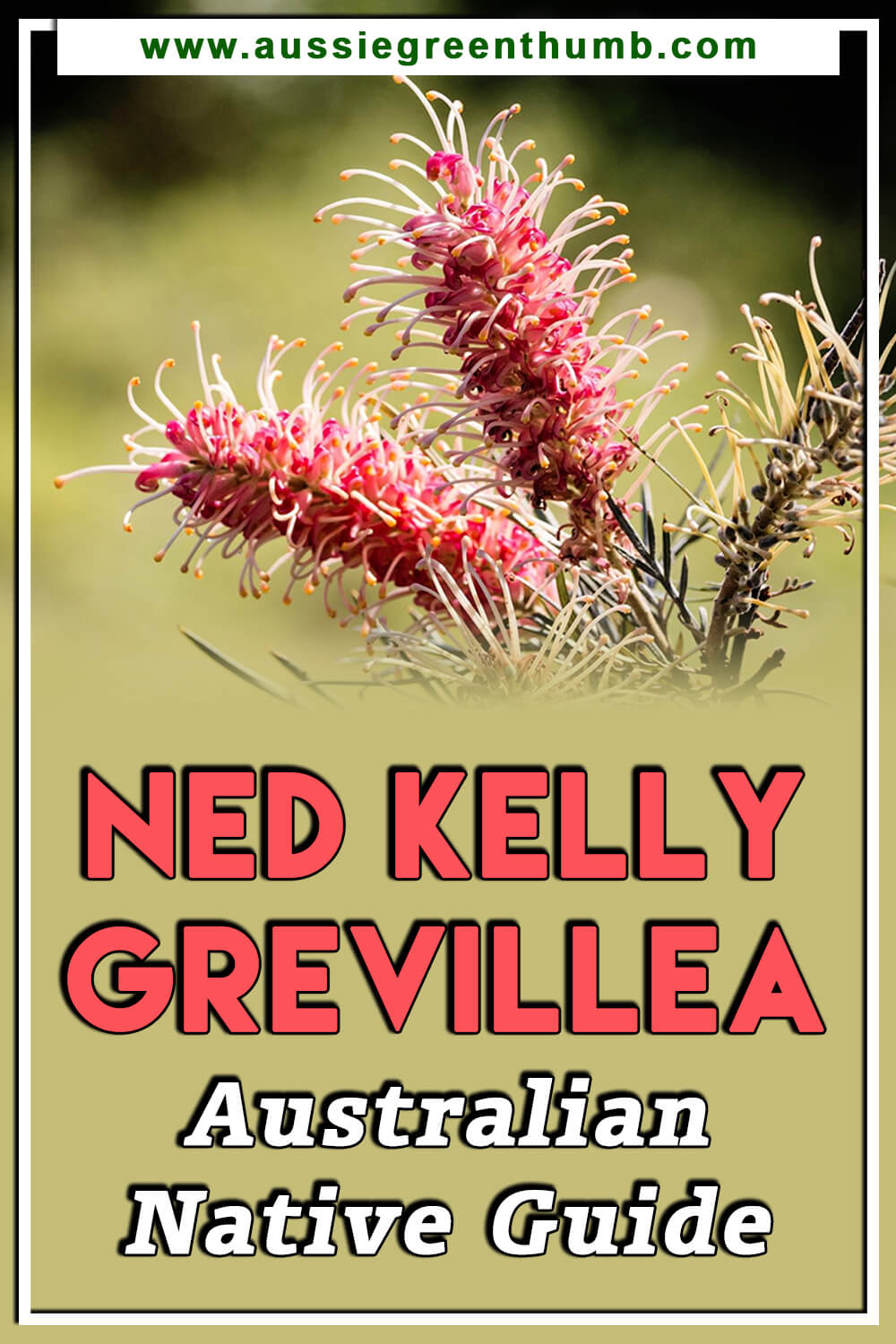
Wrapping Up Our Grevillea ‘Ned Kelly’ Gardening Guide
This showy ornamental shrub can easily add native splashes of colour and texture to your garden. Not only will the local wildlife love your new addition, but this plant’s year-round flowering will also make it a consistent attraction within your landscape.
Whether used for its excellent hedging and screening purposes or planted as a feature, the Grevillea ‘Ned Kelly’ is a must-have low-maintenance addition for any Australian garden.
Published on May 19, 2022 by Lorri Hopkins
Last Updated on February 21, 2024



